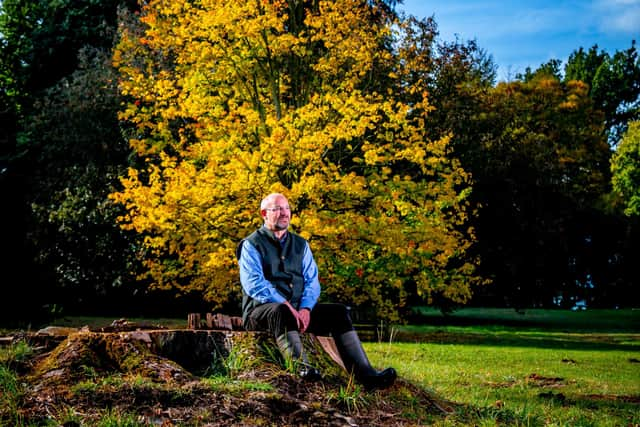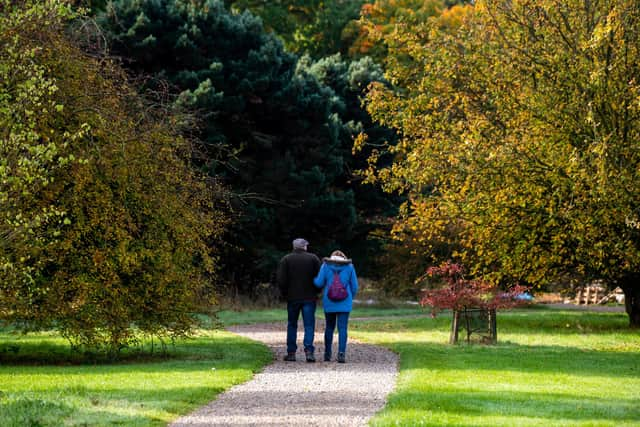Meet the man responsible for maintaining the magnificent Yorkshire Arboretum at Castle Howard
Nestled in a gentle valley at the heart of the Castle Howard estate, the 120-acre arboretum has more than 7,500 trees – including approximately 3,500 different varieties - from around the world as well as sweeping vistas, lakes, and peaceful glades.
With such diversity, the arboretum is one of the best places to view this spectacle of nature.
Advertisement
Hide AdAdvertisement
Hide AdIndeed, an annual pilgrimage of visitors flock to see the spectacular ‘many-coloured quilt’ that’s autumn at the arboretum – as the days grow shorter, the weather cools, and the trees in the arboretum are fast turning shades of vibrant red, yellow, and gold.


Given the essential role of ensuring the splendour, beauty and tranquillity remain is Yorkshire Arboretum Director John Grimshaw.
Sheffield-born John, whose passion for gardening started at his family home at the tender age of just three-years-old, and who holds a degree in Botany and a Doctorate in African Forrest Ecology from Oxford University, is quick to come up with a useful analogy: “Just like a fine bottle of wine, the trees simply get better as they mature with age!” he states.
As well as a rich tapestry of colour, the site is also especially ripe in history.
Advertisement
Hide AdAdvertisement
Hide AdThe arboretum site was formerly parkland around Castle Howard, with parts later used for agriculture.


The original bastion wall still forms much of the arboretum’s southern boundary and is a handsome feature – as are several mature parkland trees, especially oaks and sweet chestnuts, dating from the 1780s, giving height and stature to what is still a very young collection.
The arboretum as we know it today was created through the enthusiasm and partnership of George Howard (Lord Howard of Henderskelfe) and James Russell, over a period of eighteen years, from 1975 to 1992. George Howard had begun an arboretum here in 1959, but rabbits killed most of the trees, and it was not until after James Russell had moved to Castle Howard in 1968 that they turned their attention to redevelop the arboretum. During this period, the pair were also assisted by former head forester Tommy Hardisty who worked on the Castle Howard estate for more than 50 years and received a medal for his service from the Royal Forestry Society.
John, who this year celebrates his tenth anniversary at the arboretum, picks up the story of its growth.
Advertisement
Hide AdAdvertisement
Hide Ad“A large number of interesting specimens came from Hillier Nurseries in Hampshire in 1979 and form the backbone of the collection,” he states “but since then many trees planted have been of wild origin, grown from seed collected by expeditions to many parts of the world, but especially China.
“Seed or young plants have come especially from the Royal Botanic Gardens, Kew, but we receive plants from many other arboreta in the United Kingdom too. This high proportion of wild-source material, with its genetic diversity and importance for conservation, makes the Yorkshire Arboretum a significant location, and it’s regarded by Defra as a back-up collection for Kew.”
When Jim Russell retired and moved away from Castle Howard in 1992, the arboretum’s future was in jeopardy as members of the Castle Howard Estate weren’t interested in taking over its maintenance.
However, realising the importance of the collections of trees, John Simmons, then Curator of Kew Gardens, instigated the formation of the Castle Howard Arboretum Trust as a partnership between Kew and the Castle Howard Estate in 1994.
Advertisement
Hide AdAdvertisement
Hide AdThe Trust now has the remit of preserving and developing the collections, and has a membership balanced between nominees of Royal Botanical Gardens Kew, Castle Howard, and independent members.
The public was first admitted for a few open days in 1999, but increasingly thereafter. This eventually necessitated the building of the John Simmons Visitor Centre – named after an Honorary Curator of the Trust and officially opened in 2007 by the Earl of Selborne, Chairman of the Trustees at the Royal Botanic Gardens, Kew.
John Grimshaw well remembers the state of the arboretum when he took over in 2012.
He says: “Quite simply there was one full-time member of staff, three volunteers and one very run-down old tractor!
Advertisement
Hide AdAdvertisement
Hide Ad“With my passion for horticulture I realised that whilst there was no doubt a lot to be done, it was an extremely exciting challenge and one which I’d very much relish. Looking back over the last ten years, I’m extremely proud of what we’ve achieved through the efforts and commitment of both full-time staff and our enthusiastic team of volunteers which now numbers around 60.”
One of the major developments during the last ten years has been the construction of the UK’s first Tree Health Centre – a purpose-built facility to expand public awareness about the threats to our trees posed by an increasing number of pests and diseases, and the need to keep our trees as healthy as possible.
The centre includes the latest IT and visualisation teaching equipment. It works with professional and learned societies, regulatory bodies, and educational establishments to provide a mix of accredited and general courses on tree health survey, inspection and assessment techniques and plant biosecurity, as well as a range of courses on related subjects.
John comments: “Our trees are threatened by an unprecedented array of pests and pathogens. Protecting our trees has never been more important – everyone is a stakeholder in tree health, from private householders with a back garden tree to the Highways Agency and councils. All need to know how to maintain healthy trees or identify and manage those affected by pests and disease.
Advertisement
Hide AdAdvertisement
Hide Ad“The Government has identified a significant skills shortage in the field, and this lack of understanding around biosecurity has contributed to the current crisis. The Tree Health Centre is of vital importance in the promotion of healthy trees for a healthy future.”
Whilst the 120-acre site provides outstanding beauty, relaxation, and tranquillity for its hordes of visitors, the arboretum has an extremely important scientific research purpose as well.
John explains: “With natural habitats being destroyed or damaged at an alarming rate, the presence of wild-origin plants in cultivation ensures a source of seed for potential rehabilitation schemes that maintains at least some of the species’ genetic diversity. They can also be used as sources of genetic material for botanical research.
“Our trees also tell another story – of the endeavours made by collectors to bring the seed back from the wild. We’re fortunate to have specimens grown from material attributable to almost every notable plant collector active in the past 160 years. We’ve got rhododendrons derived from seed collected in 1849, while other plantings include specimens from many recent expeditions from Kew and other botanic gardens.
Advertisement
Hide AdAdvertisement
Hide AdHe continues: “The collection here is exceptionally well labelled, with each tree having a label attached to a branch, usually on the western side of the tree, and another on a stake in front of it. Without accurate labelling the tree becomes of ornamental interest only, as the data that’s of scientific value is lost.
“All our records are maintained on a database and provide a full record of the tree’s provenance and its planting history which is of huge interest.”
So, what does the future hold for The Yorkshire Arboretum?
John says: “Our primary aim at the Yorkshire Arboretum is the development and maintenance of the tree collection, helping to maintain genetic diversity in a global and national context. In doing so, we also create habitat for wildlife that can find refuge here from the intensive agriculture in the surrounding countryside.”
Aligned to its mission to promote health trees and healthy woodland, the arboretum is currently developing a new enclosure which will cover 3,000 square metres, and not only provide an effective facility to interpret the ecological and economic consequence of grey squirrels to natural and commercial woodland and the need to manage them, but also offer a unique experience.
Advertisement
Hide AdAdvertisement
Hide AdJohn concludes: “This exciting project will enable visitors to encounter this iconic native animal, which has long been extinct from this area, while learning about its role in our woodlands.”
The Yorkshire Arboretum is offering half-price entry between November 19 and 30, to commemorate National Tree Week. Visitors can purchase admission online or pay on arrival. www.yorkshirearboretum.org.